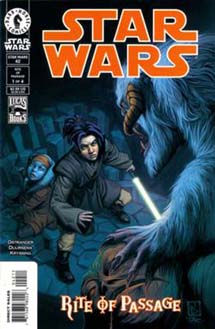“Episode II: Attack of the Clones” came out in May 2002, but that month’s issue of “Star Wars: Republic” — No. 42, the start of “Rite of Passage” – didn’t jump directly into the Clone Wars. I’m guessing that the folks at Dark Horse needed a bit of time to map out their Clone Wars stories, which would launch with Issue 49 in January 2003.
Nonetheless, “Rite of Passage’s” (42-45) release at the same time as “Attack of the Clones” has synergy, as Count Dooku makes his comic debut and Aayla Secura has a starring role. George Lucas liked the look of the blue-skinned Twi’lek Jedi, so Aayla – played by Amy Allen — made her film debut as one of the many Jedi in the Battle of Geonosis. Here’s an interesting bit of trivia: Aayla’s master, Quinlan Vos, also comes from the movies. He was in “Episode I” in the background of a Mos Espa street scene on Tatooine. It’s such a blink-and-you’ll-miss-it appearance that there are no records of who played the role of Vos. In “The Stark Hyperspace War,” Aayla says that she was with her master at that time (although she can’t be seen in the film).
It’s cool how Aayla’s and Quinlan’s roles in “Rite of Passage” have flipped from “Darkness,” where Quin talked his student back from the brink of evil. Because of her lekku, which store memories, Aayla has totally overcome the memory-loss effects of the glitteryl she was poisoned with. She is working undercover as a slave girl on her home planet of Ryloth as part of a mission with Master Tholme. On the other hand, the glitteryl erased the memories of Quinlan, a member of the Kiffar species.
Quinlan makes a good point: “Am I changed? I can’t tell. All beings change.” There’s a sadness to this arc because Aayla feels a bond with Quin that goes back to their childhoods — when Tholme and Quin visited Ryloth and brought Aayla back to the Jedi Order — but from his perspective, she’s a stranger. Still, he admits: “There are bonds between master and Padawan that go beyond memory.”
Boosted by the gorgeous pencils by regular John Ostrander collaborator Jan Duursema (with inks by Ray Kryssing and colors by Brad Anderson), “Rite of Passage” ends with Quin earning the rank of Jedi Master and Aayla becoming a Jedi Knight. It puts a period on the first chunk of “Republic” stories, which take place from zero to four years after “The Phantom Menace.”

“Honor and Duty” (46-48) jumps ahead five years and takes place just one year before the events of “Attack of the Clones.” Issue 46 marks the first time the ongoing title is labeled “Republic,” in order to contrast with “Star Wars: Empire,” which launched in 2002. I remembered “Honor and Duty” for two things: It features a younger version of Senator Simon Greyshade, marking the first linkage between a Marvel character and a Dark Horse character. And I remembered the sparse art by C.P. Smith being jarring in the wake of the solid lines of “Republic” mainstays Duursema and Davide Fabbri. I have to give Smith credit for one thing, though: He effectively draws the Coruscant garbage pit races that were hard to picture in the Greg Bear novel “Rogue Planet.”

Ostrander’s political intrigue plot hinges on a crucial anti-corruption vote that is hampered by an assassin targeting senators. Due to the threats, the vote doesn’t happen. This seems like a case of the Republic letting the terrorists win, and that’s something that should’ve been explored further. At any rate, due to the Republic’s kowtowing, systems begin to secede from the Republic (which is their legal and moral right), presaging the Clone Wars.
But the character stuff is good: Fans of the red guards got “Crimson Empire,” and fans of the blue guards (Coruscant’s Senate building guards) get “Honor and Duty.” One of the guards, Sagoro Autem, gradually realizes that serving the “ideals” of the Republic is a lame excuse when, in practice, you’re propping up the corruption. Unfortunately, it takes the break-up of his family before he realizes this. “I’m sorry, partner,” he says to a fellow guard who is arresting him. “The Republic’s not worth it. Maybe it never was.”
Obi-Wan and Anakin serve as Greyshade’s bodyguards in a preview of their “Episode II” role as Padme’s protectors, and this arc marks the first time that they have anything more than a cameo in “Republic.” A Jake Lloyd-era Anakin appeared in “Emissaries to Malastare” and a young Obi-Wan appeared in the pre-“Phantom Menace” yarn “The Stark Hyperspace War.” But it’s certainly not the last time we’ll see “Star Wars’ ” most famous Jedi duo, as the Clone Wars-era issues will often feature them. It’s also not the last time we’ll see Autem, as — unlike far too many intriguing one-off characters – we’ll check in with him later on the timeline, in Issue 78.
Since this marks the end of the pre-Clone Wars batch of “Republic” comics, it’s a good time to rank the story arcs. My rankings are: 1) “Twilight,” 2) “Rite of Passage,” 3) “Darkness,” 4) “The Stark Hyperspace War,” 5) “Outlander,” 6) “The Hunt for Aurra Sing,” 7) “The Devaronian Version,” 8) “Infinity’s End,” 9) “Honor and Duty,” 10) “Emissaries to Malastare,” 11) “Starcrash” and 12) “Prelude to Rebellion.”

